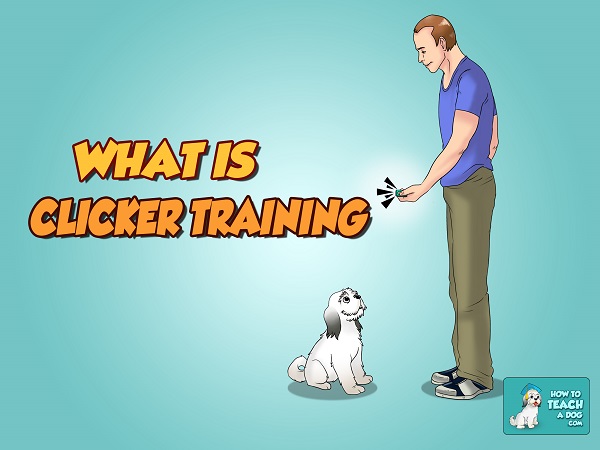
You may have heard about what is clicker training, the fast-growing training trend that has reunited dog enthusiasts and trainers across the globe. Considered more a philosophy than a training method, clicker training has become popular because it delivers cutting-edge precision and fast results in a relatively short period of time. The best part is that all you need is a clicker and some tasty treats.
What if you don’t have a clicker or don’t want to use one? While it’s preferable that you use a clicker to clicker train a dog, the good news is that you can still effectively train your dog without a clicker once you get accustomed with the principles behind clicker training. We’ll take a sneak peak at the process in the next paragraphs, but let’s first better understand what exactly clicker training is and how it can benefit you and your dog.

A Glimpse into Clicker Training
As the name implies, clicker training involves the use of a clicker, but what exactly is a clicker? At its most basic level, a clicker is simply a noise-making device shaped like a box. Its name derives from the clicking sound it produces when you depress one end your thumb. To a dog who has never been exposed to a clicker, the noise it produces may be quite insignificant. However, dogs who have been properly introduced to the clicker, understand that it provides important feedback. To better understand how it works, let’s start with an example.
Imagine going to a fun carnival where you get to play many different games that reward you with prizes. One particular games consists of throwing a wooden ring around the neck of an object placed on a table. Every time you aim right and get the ring around the item, you hear a sound that announces your victory along with flashing lights. Seconds later, you get to pick your reward, a stuffed animal of your choice.
Clicker training works in a similar fashion. Just as in the ring-tossing game, the sound and flashing lights communicate you have won, the clicking noise tells your dog he has performed a correct behavior and has earned a reward under the form of a tasty treat. The clicking sound therefore becomes a marker, something that “marks” the correct behavior as it unfolds and communicates to your dog that he got it right.
For this reason, clicker training is sometimes referred to as “marker training.” As mentioned though, dogs aren’t born knowing that the clicking sound means approval. In order to learn the meaning of the clicker, dogs must be conditioned to its use through a brief process dog trainers call “charging the clicker.”
Charging the Clicker with Power
To get started on the right paw, as mentioned, you’ll need to “charge the clicker.” All you will need for this process is a clicker and some treats. Start in a quiet room without distractions. Keep in mind that during this process you won’t be asking your dog for any particular behavior. Simply click the clicker and immediately toss a treat. Repeat, repeat, repeat. Do this several times in a row.
What you are trying to accomplish here is teaching your dog that the click is followed by treats. From a noise that initially meant nothing to your dog, you are now turning it into a much look-forwarded noise that soon becomes music to your dog’s ears!
How can you determine you’ve successfully charged the clicker? Observe your dog. If at the sound of the clicker your dog gives signs of anticipating the treat, most likely your dog has made the association. Generally, it takes anywhere between 8 and 15 reps of clicking and treating to get a reliable response. Now, that the clicker is powerfully charged, you’re ready for the next step which involves adding the “operant” component.
Making Clicker Training Happen
Now that your dog has learned that click equals treat, it’s time to make your dog work for clicks. If you are trying to train your dog to sit, you would click your clicker the moment your dog’s rear touches the ground and you would immediately reward. If you are training your dog to heel, click your clicker the moment your dog comes right next to you in heel position.
To make the process easier, you can use a leash clicker. If you are training your dog to target a stick, click the clicker the moment his nose makes contact with the stick and reward. To avoid juggling a clicker and a target stick, a Clik Stik can help free up your hands.
What if your dog is tentative in performing behaviors or has never been trained before? In this case, you may need to split exercises in smaller steps and reward gradual approximations of the final behavior, a process known as shaping. So if for instance, you’re teaching your dog to target your hand, you may first click for looking at your hand, then walking towards your hand, then sniffing your hand and then finally making contact with your hand.
In order to provide clarity and make clicker training effective, you’ll need to make sure you’re clicking right when the wanted behavior is happening. Timing is very important! If you’re even a split second late, you risk marking the wrong behavior. For instance, if you click and reward your dog the moment he gets up from sitting, you’ll have rewarded getting up instead of sitting, not what you may have been hoping for! Mastering the art of clicker training takes good timing and skill, even the best trainers attend courses to improve their skills.
Alternatives to Using Clickers
As mentioned, you don’t have to necessarily rely on a clicker to reap the rewards of the clicker training principles. If you’re hesitant to use a clicker because you’re afraid you’ll be stuck carrying a clicker all the time, there’s some good news for you. One good news is that clickers now come with handy wrist straps.
Another good news is that clickers are more important in the initial stages of learning. Once your dog had learned the exercise, the click can be replaced by a verbal marker. But what if you don’t want to use a clicker at all? While many find the clicker works best, any noise that can effectively mark behaviors as they unfold may work.
While many like to use words like “yes” or “click” in place of the click of a clicker, a noise is preferable as it’s a neutral tone that’s consistent, distinct and non-emotional. Alternatives to clickers are whistles, a snap of your fingers or a clicking noise made with your tongue. Some owners of dogs scared of the clicking sound produced by clickers, may choose instead the click a retractable pen, while owners of deaf dogs may shine a flashlight to provide feedback.
Reaping the Rewards of Clicker Training
So why are many dog enthusiasts so enamored of clicker training? There are many reasons! Clicker training provides precision and reliability, and because it’s based on rewards, dogs tend to respond with enthusiasm and high motivation. It’s not unusual to see a dog’s eyes brighten up and its tail wag at the sight of the clicker.
Clicker training is also optimal for shy dogs who are tentative and withdrawn and who need a boost in confidence. Best of all, clicker training is fun, provides mental stimulation and it helps improve the canine and human bond.


